General
Australia,is the sixth largest country in the world and is characterised by its vast landscapes, diverse ecosystems, and rich biodiversity. Covering an area of about 7.7 million square kilometers, Australia spans various climate zones, ranging from tropical rainforests and deserts to temperate grasslands and mountainous regions.
The capital of Australia is Canberra, located in the Australian Capital Territory in the southeast of the country. Canberra is a planned city, specifically built to house the capital, and is known for its remarkable architecture, green spaces, and cultural institutions, including the Parliament House and the Australian War Memorial.
Major cities
In addition to Canberra, other major cities in Australia include Sydney, Melbourne, Brisbane, Perth, and Adelaide. Sydney, located on the east coast, is the country’s largest city and is famous for its iconic Sydney Opera House and Sydney Harbour Bridge. Melbourne, the second-largest city, is known for its cultural diversity, arts scene, and sporting events.
Australia is a federal parliamentary democracy and a constitutional monarchy, with the king or queen of the United Kingdom serving as head of state, represented by a governor-general. The country boasts a prosperous mixed economy, with key sectors including mining, agriculture, tourism, and services.
Flora and fauna
Australia’s natural environment is home to a wealth of unique flora and fauna, including many endemic species found nowhere else in the world. The Great Barrier Reef, the world’s largest coral reef, located off the coast of Queensland, is one of Australia’s most notable natural wonders.
As an island nation, Australia has a rich maritime history and a strong connection to the ocean. Beach culture is deeply ingrained in the Australian lifestyle, with popular activities such as surfing, swimming, and boating playing a major role in the daily lives of many Australians.
Agriculture
Dairy farming
Australia produces a significant amount of milk for both domestic consumption and export. Annually, Australia exports about 35% of its total milk production. This amounts to more than 6 billion litres of milk exported to various international markets, including Asia, the Middle East and parts of Europe.
Average milk production per cow in Australia varies, but is generally between 5,000 and 6,000 litres of milk per cow per year. The average number of cows per dairy farm is generally between 200 and 300 cows.
Most milk production takes place in the southern and eastern regions of Australia, particularly in states such as Victoria, New South Wales, and Tasmania. These regions generally have favourable climatic conditions, fertile soil and access to water sources, which is favourable for the dairy industry.
Arable farming
Arable farming is an essential part of Australia's agricultural sector and includes a wide range of crops grown in different regions of the country.
Wheat
Wheat is one of the main crops in Australian arable farming and is grown in several regions, particularly in southern and western Australia. Major wheat-producing regions include Western Australia, South Australia, Victoria and New South Wales.
Barley
Barley is another common cereal crop in Australia, especially in drier areas. It is often grown as a fodder and cereal crop. Barley is grown in similar regions to wheat, with concentrations in Western Australia, South Australia and parts of New South Wales.
Rapeseed
Rapeseed is an important oil crop grown for both human consumption and animal feed. It is grown mainly in southern regions such as South Australia, Victoria and parts of New South Wales.
Sugarcane
Sugarcane is an important crop in Australia's tropical climate zones, particularly in Queensland and parts of New South Wales. It is grown to produce sugar and ethanol.
Cotton
Cotton is an important crop in the Murray-Darling basin in New South Wales and Queensland. Australia is known worldwide for its high-quality cotton production.
Land prices
Land prices vary widely depending on location, soil fertility and proximity to water supplies. In general, land prices are higher in areas with higher productivity and access to irrigation. In some parts of Australia, particularly in fertile agricultural areas such as south-eastern South Australia and western Victoria, land prices can range from several thousand dollars per hectare to tens of thousands of dollars per hectare, while in drier and less fertile areas, land prices are generally lower.
Climate
Australia’s climate varies significantly across the continent, with different climate zones ranging from tropical in the north to temperate in the south. Overall, the climate of Australia can be divided into four main types:
- Tropical: This climate is mainly found in northern Australia, including parts of Queensland, the Northern Territory, and the northern part of Western Australia. It is characterized by hot and humid summers, with rainy seasons often accompanied by heavy rainfall and tropical cyclones.
- Subtropical: This climate extends along the east coast of Australia, including parts of New South Wales, Queensland, and Victoria. It is characterized by warm to hot summers and mild winters, with rainfall occurring throughout the year, especially during the summer months.
- Dry (desert and steppe): Large parts of inland Australia have a dry climate, with desert areas in the center, such as the Great Victoria Desert and the Simpson Desert, and steppe areas in the west, like the Nullarbor Plain. These regions experience hot summers, cool winters, and very little rainfall throughout the year.
- Temperate: The southern parts of Australia, including areas of South Australia, Victoria, Tasmania, and the southern part of Western Australia, have a temperate climate. This includes both Mediterranean and oceanic climate zones, with mild to warm summers and cool winters, and moderate rainfall throughout the year.
Social affairs
Depending on income, parents or guardians receive benefits for each child until the child reaches the age of 16. The range of pensions, benefits, and allowances also includes disability benefits, supplementary child benefits, sickness benefits, jobseeker's allowances, and new start allowances. The amounts of various benefits and pensions are reviewed annually. Social security benefits do not require contributions and are usually paid directly to the recipient. The focus is on income support and is based on need. Eligibility for most benefits depends on an income test.


